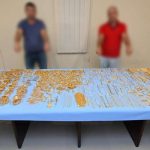Germany’s factory orders rebounded in September, as per data released by the Federal Statistics Office. The manufacturing sector in Germany showed signs of recovery with a 4.2% increase in contracts for goods ‘Made in Germany’. This was a positive turnaround from the 5.4% slump reported in August, surpassing the estimated 1.5% increase. Industrial orders in Germany also rose by 1.0% in the year through September, indicating a positive trend in the manufacturing sector.
The Euro saw some support from the strong German data, leading to a trim in losses against the US Dollar, with the EUR/USD trading near 1.0740. However, the pair was still down by 1.75% due to concerns about a potential Republican nominee Donald Trump’s presidency. Despite this, the positive outlook for the German manufacturing sector had a positive impact on the Euro.
The price of the Euro against major currencies today saw some fluctuations, with the Euro being the weakest against the US Dollar. The percentage changes in the Euro against major currencies like GBP, JPY, CAD, AUD, NZD, and CHF were also visible in the data provided. The heat map displayed the percentage changes of major currencies against each other based on the Euro as the base currency, giving a comprehensive view of the Euro’s performance in the forex market.
Overall, the rebound in Germany’s factory orders and the positive trend in the manufacturing sector are encouraging signs for the country’s economy. The strong German data provided some support for the Euro in the forex market, although concerns about political developments in the US had an impact on the currency. Despite these fluctuations, the recovery in factory orders indicates a positive outlook for Germany’s manufacturing sector in the coming months. Investors will be watching closely to see how these trends develop and the impact they have on the Euro and other major currencies in the forex market.









